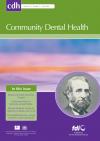Community Dental Health

- Cover Date:
- June 2009
- Print ISSN:
- 0265 539X
- Vol:
- 26
- Issue:
- 2
Association of urgent dental care with subjective oral health indicators and psychosocial impact
Pressures on public dental services require new approaches to managing demand. Objective: To identify possible predictors of urgency of clinically assessed emergency dental care using self-reported oral health indicators. Design and Methods: This study was a prospective study examining associations between patient reports of oral health indicators and psychosocial impact of oral disorders and a clinical determination of a hierarchy of urgency of emergency dental care. The data set comprised a random sample of 839 eligible adults presenting to nine public dental clinics across South Australia and New South Wales for emergency dental care. All participants held a government health concession card and were aged 18+ years and had a minimum of six natural teeth. Significant associations between self-reported oral health indicators and psychosocial impacts and a normative clinical assessment of urgency of emergency dental care were examined by means of binary logistic regression analysis in order to develop prediction models. Prediction of the urgency of emergency dental care was based on the assessment of two models –Model 1: urgency of care = <48 hours vs. 2+ days, Model 2: urgency of care = 2–7 days vs. 8+ days. Results: Some 35.8%, 34.8% and 29.4% of respondents were classified by the assessing dentist as requiring dental care within 48 hours, 2–7 days and 8+ days respectively. For Model 1, difficulty sleeping all the time (OR=4.8, CI=3.0–8.0), pain in the jaw when opening wide (OR=2.4, CI=1.6–3.7), having a broken filling (OR=1.7, CI=1.1–2.4), having a loose tooth (OR=2.4, CI=1.5–3.8), bleeding gums (OR=0.7, CI=0.5–1.0) and being dentally anxious (OR=1.5, CI=1.0–2.3) had a statistically significant association with needing to be seen within 48 hours. For Model 2, factors significantly associated with an urgency of care in the period 2–7 days included experience of toothache (OR=2.6, CI=1.6–4.3), pain in teeth with hot food or fluids (1.9, CI=1.2–2.9), bleeding gums (OR=2.0, CI=1.3–3.2), having a broken filling (OR=2.1, CI=1.2–3.5), difficulty sleeping all the time (OR=2.9, CI=1.4–6.4), and being concerned about the appearance of teeth or mouth very often (OR=0.3, CI=0.1–0.7). Conclusion: This study has identified a pertinent set of self-reported oral health indicators that can be used to predict the urgency of emergency dental care.
Key words: Emergency dental care, priority, urgency
- Article Price
- £15.00
- Institution Article Price
- £
- Page Start
- 77
- Page End
- 83
- Authors
- L Luzzi, K Jones, AJ Spencer, KF Roberts-Thomson
Articles from this issue
- Title
- Pg. Start
- Pg. End
- Editorial - NHS dental care and the issues of public service ethos, governance, accountability and probity
- 66
- 68
- Racial and ethnic differences in a regular source of dental care and the oral health, behaviors, beliefs and services of lowincome mothers
- 69
- 76
- Association of urgent dental care with subjective oral health indicators and psychosocial impact
- 77
- 83
- The use of conversation mapping to frame key perceptual issues facing the general dental practice system in England.
- 84
- 91
- Seroepidemiology of hepatitis C antibodies among dentists and their self-reported use of infection control measures
- 99
- 103
- Differences in oral health behaviour between children from high and children from low SES schools in the Netherlands.
- 110
- 115
